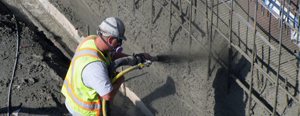Concreting in and of itself can be a fickle mistress under the best of conditions - throw in sweltering summer heat, and you could have a recipe for disaster on your hands – a situation Kryton International Inc. wants to ensure you avoid.
Summer has officially begun, which means the challenges of hot weather concreting are front and center for many projects. Ignoring the heat and continuing ‘business as usual’ with regards to the use of concrete in your construction project could have unfortunate consequences on your project timeline and further, your bottom line and good reputation.
Some of the challenges resulting in hot weather concreting are:
- Moisture Loss & Rapid Evaporation – Water is vital to freshly poured concrete which can be soaked up due to dry substrates. To protect against premature water loss, wet down substrates before pouring concrete.
 Accelerated Slump Loss – Warmer air temperatures can result in loss of slump. To prevent issues in the final product, precautions should be made to protect and cool concrete. Mixers, chutes, pump lines and other equipment coming in contact with the concrete should be shaded, covered with wet burlap or painted white to reduce solar heat. In extreme cases. Refrigerated water or ice can also be used in concrete batching. Simply increasing water to the mix is not recommended as this will lower the concrete’s strength and result in cracking, increased permeability, dusting and scaling.
Accelerated Slump Loss – Warmer air temperatures can result in loss of slump. To prevent issues in the final product, precautions should be made to protect and cool concrete. Mixers, chutes, pump lines and other equipment coming in contact with the concrete should be shaded, covered with wet burlap or painted white to reduce solar heat. In extreme cases. Refrigerated water or ice can also be used in concrete batching. Simply increasing water to the mix is not recommended as this will lower the concrete’s strength and result in cracking, increased permeability, dusting and scaling.- Faster Setting Time – The hotter the weather, the faster concrete will dry, which can make finishing more difficult and can reduce the strength and increase cracking in the final product. In order to prevent this, a retarding or hydration control admixture can help slow down setting time.
 Plastic Shrinkage Cracking– High temperature, low humidity and even wind can increase the speed of evaporation of surface moisture and increase the possibility of plastic shrinking cracking. In order to avoid this, keep concrete temperature low, dampen substrate and forms, erect temporary windbreaks and sunshades, use temporary coverings for concrete and of the slab after placing and before finishing. The addition of fibers to the concrete mic may also help reduce plastic shrinkage cracks.
Plastic Shrinkage Cracking– High temperature, low humidity and even wind can increase the speed of evaporation of surface moisture and increase the possibility of plastic shrinking cracking. In order to avoid this, keep concrete temperature low, dampen substrate and forms, erect temporary windbreaks and sunshades, use temporary coverings for concrete and of the slab after placing and before finishing. The addition of fibers to the concrete mic may also help reduce plastic shrinkage cracks.- Compressive strength – Higher water demand and higher concrete temperature could lead to reduced 28-day strengths.
Thankfully, our Krystol Internal Membrane (KIM) can help you navigate the tumultuous heat issues during this time of year with a few important benefits:
- Easily added directly to ready-mix trucks, bypassing the need to install an external membrane
- Reduces concrete shrinkage and cracking in all temperature conditions
- Reactivates the presence of moisture – extremely valuable in hot weather
- Self-seals hairline cracks up to 0.5 mm (0.02 in.)
Not only does KIM give you these undeniably crucial benefits during hot weather concreting, but also continues to be the best concrete waterproofing concrete product available for your project.
There are still some serious steps needed to be taken during warm weather concreting to ensure the job is done right; here is a checklist you should note:
- Don’t order or try to place more ready-mixed concrete than you can finish and cover
- Have sufficient labor and equipment to place concrete quickly. Delays and prolonged agitation lead to slump loss and higher concrete temperatures
- In extreme heat, begin jobs in the afternoon to capitalize on lower evening temperatures
- Avoid over-vibration: 5 to 15 seconds of vibration should give the desired compaction
- Use wind breaks whenever possible on windy days
- Spraying aggregate piles to keep them cool and damp
- Using ice or liquid nitrogen to cool concrete during batching
As added precaution to combating hot days while concreting, each ready-mix truck should carry additional superplasticizer for temperature related slump loss. Also, immediately following final finishing, begin the wet curing process, using specifications produced by the American Concrete Institute (ACI), found in ACI 309R – Guide to Curing Concrete), or apply a curing compound meeting the requirements of ASTM C309.
Despite an extremely warm weather period, the concreting process should be able to flow without incident, as long as the precautions provided are dutifully enacted.






